Science Highlights, June 28, 2015
Awards and Recognition












- James Boncella named Fellow of the American Chemical Society
- Michael Hamada elected as a Fellow of the American Society for Quality
- Snelson, Viswanathan, and Wohletz named Geological Society of America Fellows
- Stacy Copp receives University of California President’s Postdoctoral Fellowship
- Albright, Fernandes, Freeman, Losko, Rieck, Yang win Lab’s Science in “3” Awards
Earth and Environmental Sciences
Method reduces computational cost to characterize subsurface geologic heterogeneity
Explosive Science and Shock Physics
Advanced lasers simulate extreme environment of icy satellite impacts
Materials Physics and Applications
Synthetic shape tuning controls blinking suppression for two colors in “seeded” tetrapods
Materials Science and Technology
Study of damage in gallium-stabilized δ-plutonium stored at cryogenic temperatures
Awards and Recognition
James Boncella named Fellow of the American Chemical Society

James Boncella
The American Chemical Society (ACS) has selected James M. Boncella (Inorganic, Isotope and Actinide Chemistry, C-IIAC) as a 2017 Fellow. The Fellows Program recognizes members who have made exceptional scientific contributions and who have provided excellent volunteer service to the ACS community. Boncella joins just five other Laboratory scientists with the rank of ACS Fellow.
The ACS chose Boncella for his seminal discoveries in actinide chemistry and his long and distinguished history of service to the ACS, including serving as Chair of the Division of Inorganic Chemistry.
Boncella received the following citations from the ACS:
- Scientific contributions: “Recognized for seminal discoveries in actinide chemistry and pioneering high-valent uranium chemistry, as exemplified by the breakthrough discovery of the imido equivalent ([U(NR)2]2+) of the ubiquitous uranyl ion.”
- Contribution to the ACS community: “Recognized for leading major strategic planning efforts as a former Chair of the Division of Inorganic Chemistry, which led to the development of a sustainable budget and bringing Division operations into the black.”
His research in actinide organometallic chemistry led to the discovery of the bis(imido)U(VI) 2+ ion, which is the nitrogen analogue of the uranyl ion (UO2) 2+. This finding led to the discovery with A. J. Gaunt (C-IIAC) of a neptunium compound, which is the first example of a transuranic compound with a metal-ligand multiple bond with a ligand other than oxide. Boncella’s actinide research has helped to define the role of covalent interactions in actinide chemistry. He has mentored 15 post-docs, three of whom are now faculty at Ph.D.-granting institutions.
Boncella received a Ph.D. from the University of California – Berkeley, where he investigated divalent ytterbium compounds. He joined the Laboratory in 2003, working on the fundamental chemistry of uranium and other actinide species as well as a variety of other projects spanning from fuel cells to catalysts to surfactants and more. Boncella has chaired a Gordon Conference on Organometallic Chemistry, and he was named the Neil Bartlett Lecturer at the University of California – Berkeley in 2015. He has been a Laboratory deputy group leader since 2014.
Since he joined the ACS in 1981, Boncella has made many significant contributions to the organization and has held several formal positions. He has been Chair of the Division of Inorganic Chemistry, Member-at-Large, and Alternate Councilor. Boncella has served on numerous formal and ad hoc committees, and his duties as Chair included fund-raising, organizing membership drives, and organizing scientific symposia.
The American Chemical Society serves more than 157,000 members globally, providing educational and career development programs, products, and services. It is the largest scientific society in the world. In 2016 there were 995 ACS Fellows. The ACS will honor the new Fellows at the Fall ACS National Meeting in Washington, DC. Technical contact: James Boncella
Michael Hamada elected as a Fellow of the American Society for Quality

Michael Hamada
The American Society for Quality (ASQ) has chosen Michael Hamada (Statistical Sciences, CCS-6) as a Fellow. The ASQ cited him: “For significant research contributions in the design and analysis of experiments, measurement system assessment and reliability, for leadership in interdisciplinary collaborations to improve the practice of science for national security, and for dedicated service to the practice of quality.”
Hamada holds a Ph.D. in statistics from the University of Wisconsin – Madison and joined the Lab in 1998. He provides statistics and reliability support to the weapons program including the Weapons Systems Surveillance (W-9) group. Hamada was a co-recipient of the first annual Richard Feynman Prize for Innovation Achievement at the Lab in 2013. Hamada and Laboratory colleagues worked with Procter & Gamble (P&G) to develop a concept known as Reliability Technology – a statistical method that P&G has used to streamline its manufacturing processes and save more than a billion dollars a year in costs by increasing uptime in their plants worldwide. Hamada is also a co-recipient of a R&D 100 Award and a national Federal Laboratory Consortium (FLC) Award for PowerFactoRE. The technology, which was created in conjunction with P&G, is a toolkit of reliability engineering methods, statistical and analytical tools, simulation software, customized procedures, and training to help manufacturing line managers understand reliability losses, and prevent problems before they occur. Hamada received the first Gerald J. Hahn Quality and Productivity Achievement Award from the American Statistical Association (ASA), where he is a Fellow and a PStat® Accredited Professional Statistician.
ASQ is a global community of quality professionals, with nearly 80,000 members dedicated to promoting and advancing quality tools, principles, and practices in their workplaces and communities. ASQ has played a vital role in setting standards on quality management, environmental management, statistics, and social responsibility that facilitate global commerce. A Fellow candidate must be an ASQ Senior Member for at least five years and have 15 years of experience in quality related positions. Hamada is one of 18 new Fellows of ASQ. There are nearly 650 active Fellows. ASQ honored the new Fellows at the 2017 World Conference on Quality and Improvement in Charlotte, NC on April 30. Technical contact: Michael Hamada
Snelson, Viswanathan, and Wohletz named Geological Society of America Fellows
The Geological Society of America (GSA) has chosen Catherine Snelson (Geophysics, EES-17), Hari Viswanathan (Computational Earth Sciences, EES-16), and Kenneth Wohletz (EES-17) as Fellows. GSA members are nominated by existing GSA Fellows in recognition of their distinguished contributions to the geosciences through such avenues as publications, applied research, teaching, administration of geological programs, contributing to the public awareness of geology, leadership of professional organizations, and taking on editorial, bibliographic, and library responsibilities.
The Geological Society of America (GSA) is a global professional society with a growing membership of more than 26,000 individuals in 115 countries. The GSA aims to advance geoscience research and discovery, service to society, stewardship of Earth, and the geosciences profession. The Society unites earth scientists worldwide in a common purpose to study the mysteries of our planet (and beyond) and share scientific findings.
Catherine Snelson
Catherine Snelson received a citation: “For distinguished technical and administrative contributions to the Source Physics Experiment, advancing geoscience critical to our national security.”
Snelson is the Deputy Group Leader of the Geophysics group (EES-17). She earned a Ph.D. in geology and geophysics from the University of Texas – El Paso. She worked as a scientist with National Security Technologies (NSTec) and as an assistant professor at University of Nevada – Las Vegas and New Mexico Institute of Mining and Technology prior to joining LANL in 2014.
Snelson uses applied geophysics at the Lab to conduct research on national security-related problems. She also designs integrated experiments with multiple diagnostics. Snelson serves as the project manager for the Source Physics Experiment (SPE) and the Source Venture laboratory lead for the Low-Yield Nuclear Monitoring Program. During her career at the Lab, Snelson has received Los Alamos Award Program (LAAP) recognition for management of the Source Physics Experiment. She previously received a Presidential Early Career Award for Scientists and Engineers for her contributions to the characterization of the geologic structure of the Las Vegas, Nevada basin. Technical contact: Cathy Snelson

Hari Viswanathan
Hari Viswanathan received a citation: “For his stellar contributions to earth sciences over the past 20 years, his outstanding publication record on theoretical and applied research in geology and hydrology, his generous mentoring of students and peers, and his commitment to enhancing public awareness of the geosciences.”
Viswanathan leads the Subsurface Flow and Transport team of the Computational Earth Sciences group (EES-16). He received a Ph.D. in environmental engineering from the University of Illinois, Urbana-Champaign. Viswanathan is an expert in flow through porous media and reactive transport. His work examines subsurface energy extraction across multiple length scales. Viswanathan has over 100 publications in the area of energy and global security and has large multi-disciplinary projects such as reducing the water footprint of hydraulic fracturing operations. His research supports a wide range of applications including nuclear waste disposal, carbon sequestration, unconventional oil and gas, and nuclear nonproliferation. During his Laboratory career, Viswanathan has received a Los Alamos Award Program (LAAP) Outstanding EES Publication Award and the FEHM Programmatic Impact Award. Technical contact: Hari Viswanathan
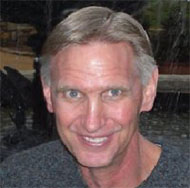
Kenneth H. Wohletz
Kenneth H. Wohletz received a citation: “For his world-class field studies and modeling of hydrovolcanic eruptions; his classified and critical investigations into means and methods for verification and monitoring of participants in the Threshold and Comprehensive Test Ban treaties; and his programming abilities combined with his pioneering use of supercomputer simulation in the earth sciences.”
Wohletz received a Ph.D. degree in geology from Arizona State University, where he studied geophysical fluid dynamics, mathematical modeling, petrologic thermodynamics, and experimental physics. He conducted postdoctoral research in planetary cratering mechanics at NASA and served as a guest scientist of the Italian National Research Council before Los Alamos awarded him a Laboratory Director’s Postdoctoral Fellowship for shockwave studies in volcanism. A technical staff member at the Lab since 1983, his research has focused on monitoring technologies for nuclear test sites, numerical simulation of weapons effects and volcanic eruptions, and explosive fragmentation and particulate characterization. Technical contact: Kenneth Wohletz
Stacy Copp receives University of California President’s Postdoctoral Fellowship
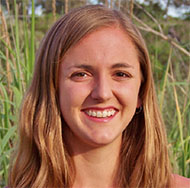
Stacy Copp
Stacy Copp (Materials Physics Applications – Center for Integrated Nanotechnologies, MPA-CINT) has been chosen for a University of California (UC) President’s Postdoctoral Fellowship. This Fellowship was established in 1984 to encourage outstanding women and minority Ph.D. recipients to pursue academic careers at the University of California. The program offers postdoctoral research fellowships, professional development, and faculty mentoring to outstanding scholars in all fields whose research, teaching, and service will contribute to diversity and equal opportunity at UC. In 2012, the UC-Affiliated National Labs were formally invited to partner with the UC Office of the President to offer UC President’s Postdoctoral Fellowship opportunities in science, technology, engineering, and mathematics (STEM), coupled with mentoring, professional development and networking opportunities at their respective laboratories.
Copp completed her Ph.D. in physics at the University of California – Santa Barbara, studying the optical properties and nanoscale arrangement of DNA-stabilized silver clusters. She worked two summers at the Center for Integrated Nanotechnologies at Los Alamos as an undergraduate intern. Copp joined the Lab as a Director’s Postdoc Fellow in January 2017. She will be co-mentored by her current Laboratory mentor, Gabe Montaño (MPAS-CINT), as well as Professor Atul Parikh (University of California – Davis). Her fellowship research focuses on designing and understanding biomimetic polymer materials that form novel photonic structures through self-assembly, with applications in light harvesting and artificial cells. Technical contact: Stacy Copp
Albright, Fernandes, Freeman, Losko, Rieck, Yang win Lab’s Science in “3” Awards
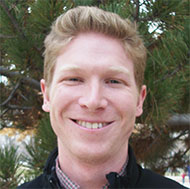
Jason Albright
Jason Albright (XTD Nuclear Threat Assessment, XTD-NTA) is a Postdoc Research Associate. He earned a Ph.D. in mathematics from the University of Utah. His postdoctoral research focuses on developing new mathematical tools to determine when scaled-down laboratory experiments in hydrodynamics can be used in place of full-scale observations. Scott Ramsey and Roy Baty (XTD-NTA) mentor him.
Topic: Symmetry Revealed
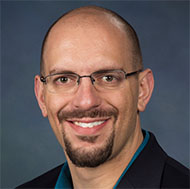
Philip Fernandes
Philip Fernandes (Space Science and Applications, ISR-1) is a Postdoc Research Associate. A NASA fellowship supported his graduate research developing electrostatic analyzer plasma instruments for NASA sounding rocket missions. Fernandes earned a Ph.D. in physics from Dartmouth College. Ruth Skoug and Herb Funsten (ISR-1) mentor him. His research interests include space plasma instrumentation, composition and dynamics of the magnetosphere during geomagnetic storms, characterizing thermal ion distributions in the ionosphere, magnetosphere-ionosphere coupling, and expanding the capability of the ISR Space Plasma Instrument Calibration Facility.
Designing the Next-Generation Spacecraft Environment Sensor
The next-generation plasma sensor, WPS (Wide-angle Plasma Spectrometer), uses a pinhole camera design to mitigate several design limitations of traditional plasma instruments. Traditional plasma instruments employ a 2-D planar field-of-view, which requires spacecraft rotation or electrostatic deflectors to cover more of the sky. WPS is designed to image nearly half of the sky from a non-spinning platform without the use of deflectors, reducing the resources required. The design enables much faster acquisition of the full energy-angle distribution of the background population and provides a means to reduce size, weight, power, and complexity.
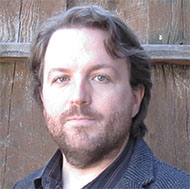
Matt Freeman
Matt Freeman, (Neutron Science and Technology, P-23 and Subatomic Physics, P-25) is a Harold Agnew National Security Postdoctoral Fellow. He earned a Ph.D. in medical physics from Duke University. Freeman works with his mentors Frank Merrill and Johnny Goett (P-23), and Fesseha Mariam (P-25) on the development of novel beamline modification and image analysis methods for proton radiography (pRad).
Topic: Proton Radiography for Imaging Low-Density Targets
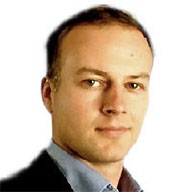
Adrian Losko
Adrian Losko (Materials Science in Radiation and Dynamics Extremes, MST-8) is a Postdoc Research Associate. He earned a Ph.D. in physics from New Mexico State University. Losko studies the development of quantitative imaging, using the pulsed neutron beam structure at LANSCE to provide unique characterization capabilities for advanced neutron imaging and diffraction for next generation fuel characterization at the Lujan Center. Sven Vogel and Don Brown (MST-8) mentor him.
Topic: Non-Destructive 3-D Neutron Imaging of Composition in Bulk Materials\
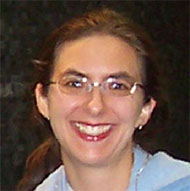
Karen Rieck
Karen Rieck (Space and Remote Sensing, ISR-2) is a Postdoc Research Associate. She received a NASA Fellowship during her graduate studies to measure solar wind collected by the Genesis Sample Return Mission. Rieck earned a Ph.D. in geological sciences from Arizona State University. She is broadening the scope of her solar wind work under a NASA Laboratory Analysis of Returned Samples grant. Roger Wiens (ISR-2) mentors her.
Topic: Solar Wind Fractionation: Linking GENESIS Mission Data to Solar Processes

Yongchao Yang
Yongchao Yang (National Security Education Center- Engineering Institute, NSEC-EI) is a Director’s Postdoctoral Fellow. He earned a Ph.D. in structural engineering from Rice University. Yang combines computer vision and machine learning approaches to develop structural sensing/imaging and modeling methods. He has won the Raymond C. Reese Research Prize of American Society of Civil Engineers. David Mascareñas (NSEC) mentors him.
Topic: Full-field Imaging and Modeling of Structural Dynamics with Digital Video
Chemistry
First synthesis and characterization of the actinium aquo ion
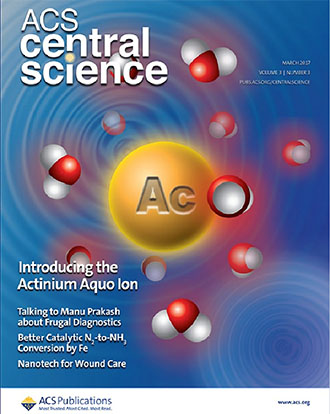
Figure 1. Journal cover. The “actinium aquo ion” is an actinium ion surrounded by water molecules that are loosely bound to it. Artwork credit: Josh Smith, LANL.
Actinium-225 (225Ac) is a particularly promising isotope for targeted anticancer therapy because it emits alpha particles that are suitable for therapeutic use, and it decays to the biologically innocuous bismuth-209 (209Bi) isotope. However, scientific and technical challenges remain in understanding the coordination chemistry that will allow effective biological delivery of this promising isotope. A Los Alamos team has been studying various fundamental aspects of actinium chemistry with the intent of realizing its medical promise. Developing an understanding of the actinium ion in water is critical for characterizing chemical equilibria that define metal complexation in biologically relevant systems. The journal ACS Central Science has published their research and featured it on the cover.
The new research focuses on the actinium aquo ion. Because metal aquo ions of the form M(H2O)xn+ are both ubiquitous and chemically important, their structures and chemical properties serve as fundamental benchmarks in exploring trends across the periodic table. Characterization of aqueous speciation provides a foundation for advances throughout chemistry and biology. For example, understanding the chemistry of metal aquo ions is essential for solving technical problems relevant to biomedical applications, metal ions in the environment, extraction, food chemistry, etc. In this sense, metal aquo ions occupy central roles in all chemical equilibria that define complexation properties of a metal by a particular ligand in aqueous media.
The team aimed to explore actinium’s chemical binding properties in support of chelator design. Unfortunately, an insufficient understanding of actinium coordination chemistry has hindered development of an appropriate actinium chelator. Gathering experimental information about actinium is difficult, primarily because all of its isotopes are highly radioactive. The most stable actinium isotopes are 225Ac and 227Ac, which have short half-lives, 10 days and 22 years, respectively. Only very small quantities of these isotopes are available for research. As a result, many basic properties associated with actinium have yet to be defined. Even something as fundamental as the actinium aquo ion, Ac(H2O)x3+ (referred to hereafter as Ac-aquo), remains poorly defined. Exploring this chemistry is one of the first steps toward establishing thermodynamic data needed for predicting actinium behavior in biologically relevant media.
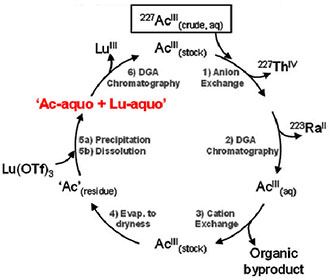
Schematic showing
The new work overcame the sample handling and spectroscopic obstacles associated with studying the actinium (III) ion in aqueous media and enabled the first characterization of the most fundamentally important actinium coordination complex, the Ac-aquo ion. The purification procedure allowed recovery of the actinium ion from inorganic and organic contaminants, and it reduced the dose rate by removing the radioactive daughters (thorium and radium). The researchers used X-ray absorption fine structure (XAFS) spectroscopy and molecular dynamics density functional theory (MD-DFT) calculations to evaluate actinium speciation in dilute triflic acid. The team compared the data with previous actinium XAFS studies and presented it in the context of what is currently understood for the other actinide (III) aquo ions. The results highlight the uniqueness of the Ac (III) ion, most notably in terms of long actinium-oxygen bond distance and possible large coordination number.
Reference: “Synthesis and Characterization of the Actinium Aquo Ion,” ACS Central Science 3, 176 (2017); doi: 10.1021/acscentsci.6b00356. Authors: Maryline G. Ferrier, Benjamin W. Stein, and Lindsay N. Redman, and Stosh A. Kozimor (Inorganic, Isotope and Actinide Chemistry, C-IIAC); Enrique R. Batista (Center for Nonlinear Studies, T-CNLS); John M. Berg (Defense and Space Power Systems, MET-5); Eva R. Birnbaum (Science Program Office-Office of Science, SPO-SC), W. Engle (C-IIAC and University of Wisconsin); and Juan S. Lezama Pacheco (Stanford University).
The Laboratory Research and Development (LDRD) program funded Berg, Birnbaum, Engle, and Redman; the DOE Heavy Element Chemistry Program by the Division of Chemical Sciences, Geosciences, and Biosciences, Office of Basic Energy Sciences funded Batista and Kozimor. Postdoctoral Fellowships from the Glenn T. Seaborg Institute sponsored Ferrier and Stein. Los Alamos Institutional computing provided computational resources through the Wolf Cluster. The DOE, Office of Science, Isotope Development and Production for Research and Application subprogram within Office of Nuclear Physics supplied the 227Ac. The work supports the Laboratory’s Energy Security and Global Security Mission areas and the Materials for the Future science pillar. Technical contact: Stosh Kozimor
Earth and Environmental Sciences
Method reduces computational cost to characterize subsurface geologic heterogeneity
Permeability of the porous media is a physical quantity of great importance for predicting flow and transport of fluids and contaminants in the subsurface. A well-understood distribution of permeability heterogeneity can be crucial for many different subsurface applications such as: 1) forecasting production performance of geothermal reservoirs, 2) extracting oil and gas, and 3) estimating pathways of subsurface contaminant transport. Conventional methods for model inversion can be extremely computationally expensive because practical problems often contain a large number of observations and unknown model parameters. Earth and Environmental Sciences Division researchers have developed a novel and computationally efficient method incorporating ideas of dimensionality reduction and parallelism to reduce the computational cost for large-scale model calibration (inversion) problems. The journal Water Resources Research published their findings, and the Laboratory has made the developed algorithms available in the open-source high-performance computational framework MADS (Model Analysis and Decision Support, http://mads.lanl.gov).

Figure 3. Schematic representation of a typical hydraulic tomographic problem where observations of hydraulic heads (pressures) at wells are applied to estimate aquifer permeability. An aquitard is a zone within the earth that restricts the flow of groundwater from one aquifer to another. The wells are used to obtain pressure observations and to estimate pressure field via fluid extraction/injection.
The team based the novel optimization method on the Levenberg-Marquardt (LM) algorithm. This method employs a projection of the original parameter space of the inverse problem down to a much smaller subspace to reduce the dimensionality of the problem. The algorithm stores the computed subspace and recycles it for future use in the calibration process. This approach significantly improves the computational efficiency of solving the inverse problems.
To evaluate the performance of this novel optimization method, researchers solved for unknown aquifer permeabilities in 2-D from steady-state observations of hydraulic heads. This generated the synthetic reference model shown in Figure 4 (left). The reference model contains 50 x 50 computational nodes at which hydraulic pressure is simulated and a total of 5100 model parameters representing permeabilities between the pressure nodes. This inverse method obtains a good result (Figure 4, right) and captures both the high and low permeability regions.
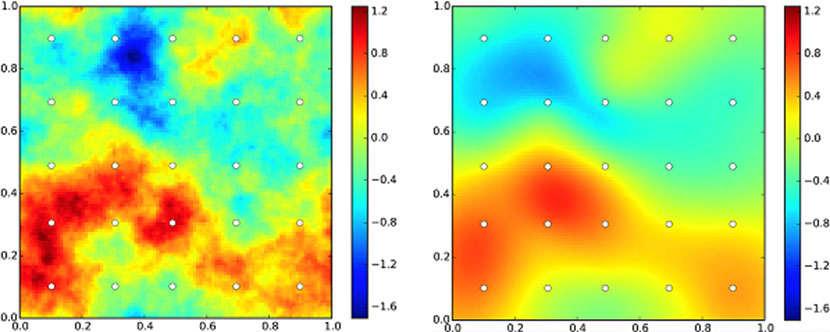
Figure 4. (Left): Synthetic log-permeability field. (Right): The result of the inverse modeling solved by the newly developed LM algorithm as shown. Circles indicate locations of the hydraulic head observations.
The new LM method provides a comparable accuracy to those of the conventional optimization methods, and a significantly improved computational efficiency. A comparison of the new LM method with two other convention LM methods demonstrated a speed-up ratio on the order of 101 to 102 in a multi-core computational environment. Lab researchers have coded the novel optimization method in the Julia high-performance dynamic programming language and implemented it in the open-source high-performance computational framework MADS (http://mads.lanl.gov), leading to a more efficient computational capability to characterize the large-scale subsurface geologic heterogeneity.
References:
“A Computationally Efficient Parallel Levenberg-Marquardt Algorithm for Highly Parameterized Inverse Model Analyses,” Water Resources Research 52, 6948 (2016); doi: 10.1002/2016WR019028. Authors: Youzuo Lin (Geophysics, EES-17), Daniel O’Malley and Velimir V. Vesselinov (Computational Earth Sciences, EES-16).
“MADS: Model Analyses and Decision Support”; http://mads.lanl.gov, http://github.com/madsjulia, http://madsjulia.github.io/Mads.jl and examples of MADS test problems and applications: http://madsjulia.github.io/Mads.jl. Authors: Velimir V. Vesselinov and Daniel O’Malley (Computational Earth Sciences, EES-16), Youzuo Lin (Geophysics, EES-17), and others.
The Los Alamos National Laboratory Environmental Programs Projects funded Lin and Vesselinov, the LANL Director’s Postdoctoral Fellowship program sponsored O’Malley, and the DiaMonD project (An Integrated Multifaceted Approach to Mathematics at the Interfaces of Data, Models, and Decisions, DOE, Office of Science) funded some aspects of Vesselinov’s research. The work supports the Lab’s Energy Security mission area and the Information, Science, and Technology science pillar via computations for energy and environmental applications. Technical contact: Youzuo Lin
Explosive Science and Shock Physics
Advanced lasers simulate extreme environment of icy satellite impacts
Researchers used the high-brightness, short-pulse Linac Coherent Light Source at the SLAC National Accelerator Laboratory to simulate and image in real time the extreme environment of liquid water shock freezing into ice. Physical Review Letters published the research and highlighted it as an Editor’s Suggestion.
Water (H2O) is one of the most abundant molecules in the Universe. Under the conditions on Earth, ice primarily exists in hexagonal crystal found in glaciers and snowflakes. This form of ice is denoted ice Ih. The new research revealed the unexpectedly swift transformation of water into high pressure crystalline ice phase VII – a dense ice phase found in the interiors of icy satellites.
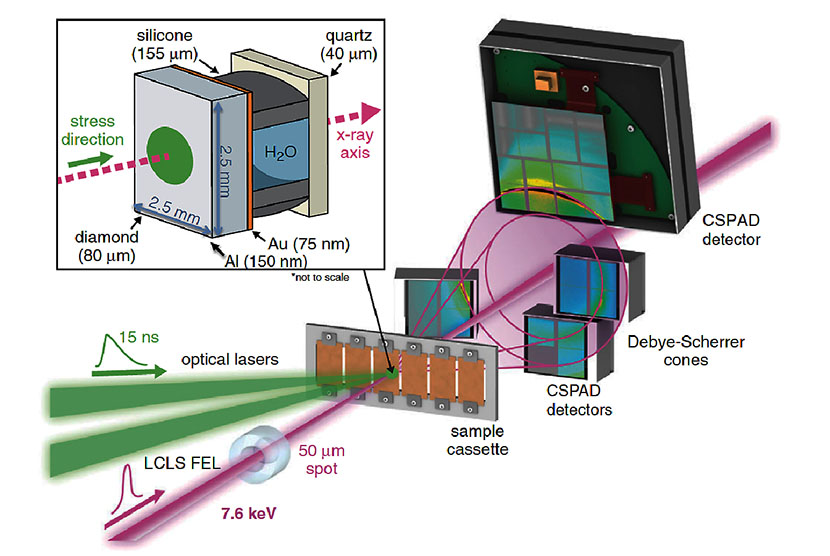
Figure 5. Schematic of the Matter in Extreme Conditions target chamber at the Stanford Liner Accelerator facility (SLAC). Green beams are the drive laser used to generate the shock wave, while the pink beam (X-rays) probes the changes in the sample’s atomic structure. The XRD is recorded downstream of the sample (black arrow). (Inset): Schematic of the target package as a cut away side view.
Although pressure- and temperature-induced phase transitions have been studied for more than a century, little is known about the non-equilibrium processes by which the atoms rearrange. Shock compression, the fastest mechanical loading that can be applied to a material, generates a rapidly propagating high-pressure/temperature condition. In situ x-ray diffraction (XRD) can probe the time-dependent atomic rearrangement that occurs
The team used the Linac Coherent Light Source, the world’s most powerful X-ray laser located at the nearby SLAC National Accelerator Laboratory. The researchers beamed an intense laser at a small target containing a sample of liquid water. The laser instantly vaporized layers of diamond on one side of the target, generating a force that compressed the water to pressures exceeding 50,000 times that of Earth’s atmosphere at sea level. As the water compacted, a separate beam from the X-ray Free Electron Laser (FEL) arrived in a series of bright pulses only a femtosecond (10-15 second) long. The strobing X-ray laser snapped a set of x-ray diffraction (XRD) images revealing the progression of molecular changes while the pressurized water crystallized into ice VII. The phase change took just 6 nanoseconds and revealed a fundamental disorder-to-order transition. The water molecules initially crystallized into needle shapes, and not spheres as theory had predicted. These are the first femtosecond-long XRD observations of the shock freezing of water.
The findings may help refine thermodynamic models for solid-liquid phase transitions. These results could lead to a greater understanding of important problems in shock physics, materials science, and potentially refine planetary models providing insight for the impact history of the solar system. The new experimental approach advances the study of phase transition kinetics enabling the design new materials with improved functionality.
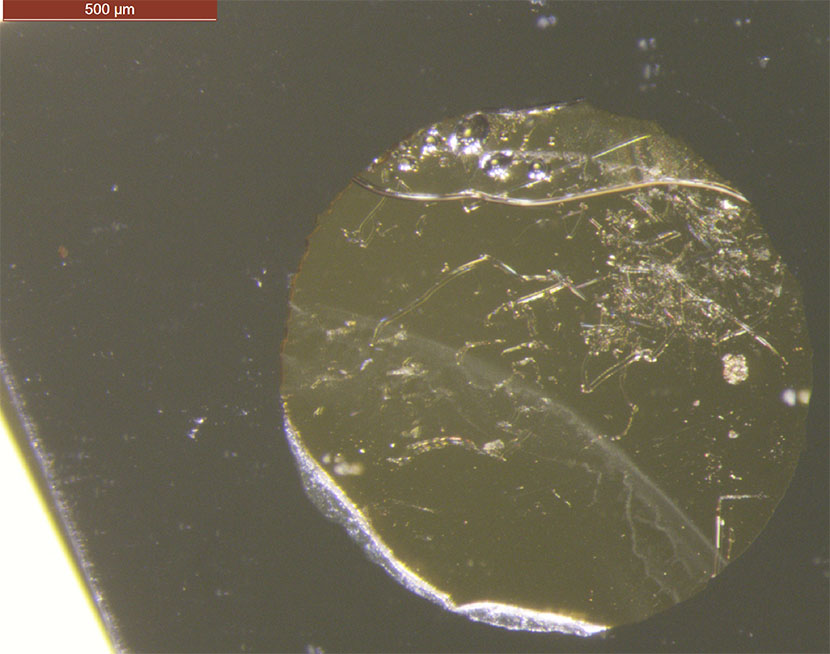
Photo. A circular water layer sandwiched between a diamond platelet coated with gold and a quartz platelet. The water layer transforms into ice VII after being blasted by an intense green laser.
In situ XRD, such as available at the Linac Coherent Light Source and planned at the center of MaRIE (Matter-Radiation Interactions in Extremes), LANL’s proposed experimental facility for time-dependent materials science at the mesoscale, provides a unique tool to study materials under extreme conditions. MaRIE would take this research further by allowing structural determination of non-crystalline materials and by performing the time-dependent measurements on a single shock event. Additional dynamic drivers could enable longer time measurements of the crystallization dynamics near the phase boundaries.
Reference: “Compression Freezing Kinetics of Water to Ice VII,” Physical Review Letters 119, 025701 (2017); doi: 10.1103/PhysRevLett.119.025701. Authors: Arianna Gleason (Shock and Detonation Physics, M-9 and SLAC National Accelerator Laboratory), Cindy Bolme (M-9), E. Galtier, H. J. Lee, E. Granados (SLAC National Accelerator Laboratory); D. H. Dolan, C. T. Seagle, and T. Ao (Sandia National Laboratories); S. Ali, A. Lazicki, D. Swift, and P. Celliers (Lawrence Livermore National Laboratory); and W. L. Mao (SLAC National Accelerator Laboratory and Stanford University).
The Laboratory Directed Research and Development (LDRD) program sponsored the Los Alamos work, and a Reines Distinguished Postdoctoral Fellowship funded Gleason. The research supports the Lab’s Nuclear Deterrence mission area and the Materials for the Future science pillar by demonstrating a strategy and methodology to extract phase transition kinetics using time-resolved x-ray diffraction data. Learning to manipulate those transitions might open the way to engineer materials with exotic new properties for useful applications. Technical contact: Arianna Gleason
LANSCE
Ra’anan Tobey named Rosen Scholar
The Laboratory has chosen Ra’anan Tobey (Zernike Institute for Advanced Materials at the University of Groningen, Netherlands) as the 2017-2018 Rosen Scholar.
The Rosen fellowship, created in memory of Laboratory physicist Louis Rosen, known as the father of the Los Alamos Neutron Science Center (LANSCE), aims to attract visiting scholars to LANSCE in the fields of nuclear science, materials science, defense science, and accelerator technology.
As Rosen Scholar Tobey will develop real-time imaging capability of nucleation dynamics in complex oxides and itinerant ferromagnets. He will combine his expertise in transient grating spectroscopy with the Laboratory’s expertise in coherent diffraction imaging to achieve this goal. Tobey will use this technology to probe the dynamics of competing phases to gain further understanding of materials performance. The techniques and expertise developed with this work will benefit the proposed Matter-Radiation Interactions in Extremes (MaRIE) facility.
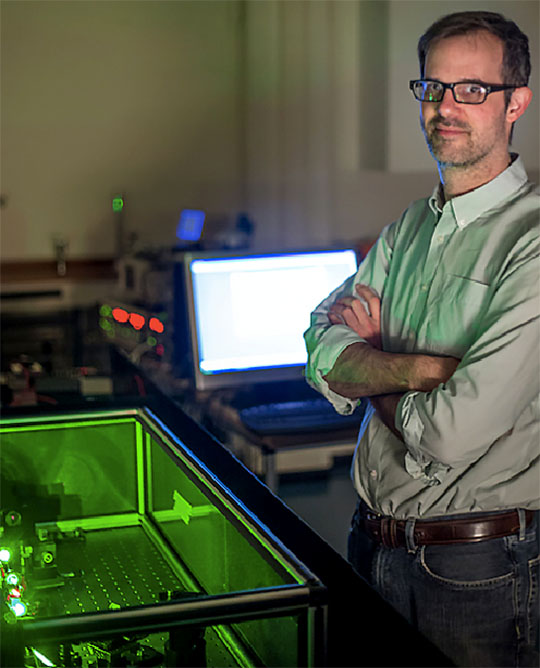
Ra’anan Tobey
Tobey has developed techniques to capture ultrafast materials dynamics. He is a pioneer in applying the ultrafast optical and x-ray technique known as transient grating to magnetic and electron processes. Tobey has extensive leadership in using ultrafast optical, x-ray, and electron probes to study correlated electron and magnetic processes on the femtosecond and nanometer to atomic scales. His experience includes research on dynamics in magnetic and strongly correlated materials, ultrafast optics, time-resolved visible, terahertz, infrared, and soft x-ray spectroscopy; transient grating spectroscopy; ultrafast electron diffraction; synchrotron and free-electron laser science; cryogenics, and magnetic fields.
Tobey earned a Ph.D. in physics from the University of Colorado. He has led or participated in many seminal ultrafast spectroscopy and imaging experiments and has more than 35 high-impact papers in journals such as Science, Nature, Nature Photonics, Scientific Reports, and Physical Review Letters. Before joining the University of Groningen, he held postdoctoral positions at Brookhaven National Laboratory and the University of Oxford. Technical contact: Gus Sinnis
Materials Physics and Applications
Synthetic shape tuning controls blinking suppression for two colors in “seeded” tetrapods
Quantum dot-seeded tetrapods are a type of nanostructure that is capable of dual light emission – one color is emitted from the quantum dot core and another from four arms protruding from it. For the first time, Los Alamos researchers and colleagues investigated the process of seeded-tetrapod dual emission at the level of single nanostructures. They synthesized a series of tetrapods having different arm lengths and thicknesses to determine the key geometric parameters controlling blinking and photobleaching, and even the attribute of two-color emission itself. This new understanding allowed them to simultaneously control the multicolor emission process and photostability in the case of engineered nanostructures. Nature Communications published the research.
The researchers’ earlier work in ultrastable non-blinking and non-photobleaching “giant” quantum dots informed these investigations of seeded tetrapods. The investigators discovered that the more complex and asymmetric tetrapods are an even more versatile platform for controlling and fine-tuning emission processes of nanoscale semiconductors. For this study they combined traditional (but optimized) tetrapod synthetic techniques with techniques developed previously only for quantum dots. The team used widefield optical microscopy, single-photon-counting, and ensemble transient absorption techniques to assess the complete tetrapod shape series. This information enabled them to establish a new mechanistic understanding for dual-color multiexcitonic emission. The researchers determined the structural parameters for intentionally “engineering” unprecedented performance metrics of blinking-suppressed two-color multiexcitonic and even tricolor photoluminescence.
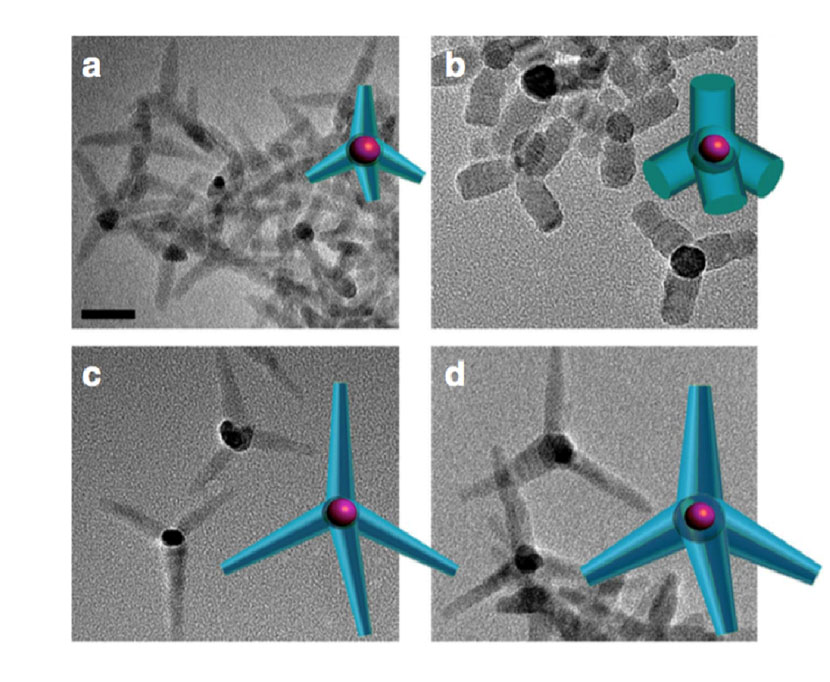
Figure 6. Electron microscopy images for a nanoengineered tetrapod shape series composed of cadmium selenide in the core and cadmium sulfide in the arms. (a–d) Transmission electron microscopy images of four tetrapods (also shown schematically) differing in arm diameter and arm length, respectively.
Semiconductor nanostructures that can emit from two excited states and therefore produce two photoluminescence colors are of fundamental significance and have potentially useful technological uses. For example, these materials could be used in energy applications such as nanoscale thermometers for highly sensitive ratiometric temperature sensing or new photon sources for white-light generation. Dual-emitting nanostructures are model systems for understanding exciton generation and even more complex multiexciton formation and radiative-relaxation processes in quantum-confined structures.
“Materials by design” is a centerpiece of the Laboratory’s Materials for the Future science pillar. The ability to correlate nanoscale architectures with functionality is a key step toward achieving this goal. Underpinning the approach is the need for sophisticated synthetic strategies that can target the most useful nanocrystals.
Reference: “Using Shape to Turn Off Blinking for Two-Colour Multiexciton Emission in CdSe/CdS Tetrapods,” Nature Communications 8, 15083 (2017); doi: 10.1038/ncomms15083. Authors: Noah J. Orfield, Zhongjian Hu, Sachidananda Krishnamurthy, Han Htoon, and Jennifer A. Hollingsworth (Materials Physics Applications – Center for Integrated Nanotechnologies, MPA-CINT); Nimai Mishra and Feng Wang (formerly MPA-CINT); Joanna L. Casson (Physical Chemistry and Applied Spectroscopy, C-PCS); Milan Sykora (Inorganic Isotope and Actinide Chemistry, C-IIAC); and Anton V. Malko (The University of Texas at Dallas.
The DOE Office of Basic Energy Sciences’ Division of Materials Science and Engineering primarily funded the research at Los Alamos. Investigators performed work at the Center for Integrated Nanotechnologies (CINT), a DOE Office of Science User Facility operated jointly by Los Alamos and Sandia National Laboratories. CINT User Projects sponsored some aspects of the research. The work supports the Laboratory’s Energy Security mission area and the Materials for the Future science pillar (emergent phenomena theme) by enabling the design of new functionality in tailored material that can perform in ways beyond their basic properties. Technical contact: Jennifer A. Hollingsworth
Materials Science and Technology
Study of damage in gallium-stabilized δ-plutonium stored at cryogenic temperatures
Predicting how radiation damage will alter the properties of a material and how those property changes evolve over time requires a detailed knowledge of the damage processes associated with radiation damage. Understanding the damaging effects of self-irradiation in plutonium (Pu) can be challenging, due in part to difficulties in obtaining appropriate potentials for Pu. Plutonium metallurgy is inherently complex due to changes in chemistry and structure that result from radioactive decay. Simulations of the effects of self-irradiation of δ-Pu highlight the importance of the delicate interplay between damage creation processes and recovery processes in the evolution of microstructure. To separate those two processes and gain a better understanding of them, cryogenic aging can enable damaged local structure to accumulate quickly, followed by isochronal annealing to study the damage repair mechanisms as the material rewarms. The Journal of Applied Physics has published these findings.
The team performed cryogenic aging to examine the damage creation and recovery processes in the evolution of Pu microstructure. They used using extended x-ray absorption fine structure (EXAFS) analysis to investigate self-irradiation damage on the local structure of gallium (Ga) stabilized δ-Pu stored at cryogenic temperatures. After 72 days of storage below 15 K, the investigators observed a loss of local order, indicating extensive damage. The effect occurred from both the Pu and the Ga sites, and shows changes in local coordination throughout the damage recovery process.
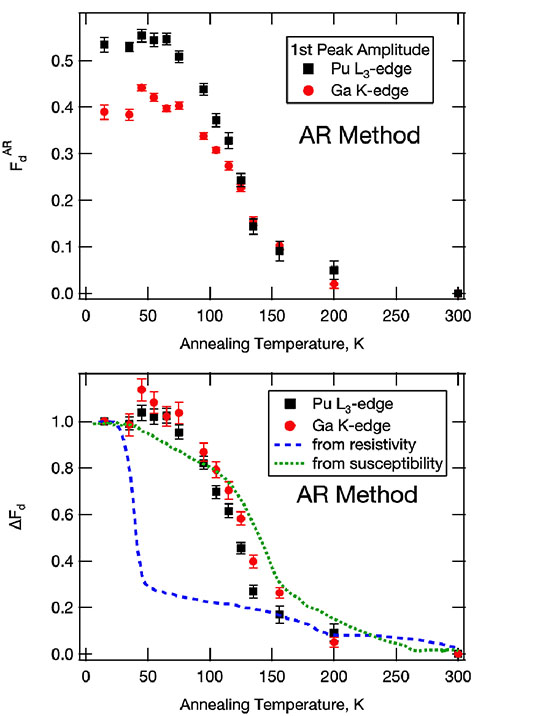
Figure 7. (Top panel): Damage to local structure of δ-Pu after cold storage for 72 days below 15 K as determined by peak amplitude. (Bottom panel): The data are replotted to show the normalized fraction of residual damage present as a function of annealing temperature along with similarly normalized data from the previous resistivity and susceptibility isochronal annealing experiments.
The team modeled the data using a spherical crystallite model to parameterize the size and fraction of undamaged regions in the material. This provided insight into damage production, annealing mechanisms, and the role of Ga in restoring order to the damaged lattice.
The primary practical interest in plutonium lies with its importance for energy generation applications in both nuclear power and nuclear weapons. However, there are also connections to fundamental science because understanding damage at the atomic level is complicated by plutonium's unique electronic and structural properties. An understanding of the electronic properties is required for calculating the structure and thermodynamics of plutonium and its compounds from first principles.
Reference: “Isochronal Annealing Effects on Local Structure, Crystalline Fraction, and Undamaged Region Size of Radiation Damage in Ga-stabilized δ-Pu,” Journal of Applied Physics 120, 035103 (2016); doi: 10.1063/1.4958856. Authors: Daniel T. Olive and Franz J. Freibert (Nuclear Materials Science, MST-16), Deborah L. Wang (Lawrence Berkeley National Laboratory and University of California – Berkeley), Corwin H. Booth, Scott K. McCall, Mark A. Wall, and Patrick G. Allen (Lawrence Berkeley National Laboratory); Eric D. Bauer (Condensed Matter and Magnet Science, MPA-CMMS), and Alison L. Pugmire (Engineered Materials, MST-7).
The Laboratory Directed Research and Development (LDRD) program and the Glenn T. Seaborg Institute for Transactinium Science funded the work at Los Alamos. The research supports LANL’s Nuclear Deterrence and Energy Security mission areas and its Materials for the Future science pillar by providing insight into the effects of radiation damage on plutonium. Technical contact: Dan Olive
Physics
Muon detector developed for subsurface borehole imaging
A research team is examining how cosmic ray muon tomography could precisely and completely image the density distribution in the Earth’s subsurface to provide a direct, real-time, and low-cost method for monitoring fluid displacement in subsurface reservoirs. Such technology could also observe the sequestration of the greenhouse gas carbon dioxide (CO2) and track fluid migration during injection or hydrocarbon production. These are timely applications given concerns about such as human-induced seismicity and chemical leakage into aquifers. The journal Nuclear Instruments and Methods in Physics Research Section A: Accelerators, Spectrometers, Detectors and Associated Equipment has published their developmental work.
Muons are generated naturally in the upper atmosphere from cosmic ray interactions. Due to their high energies, ubiquitous availability, and highly penetrating nature, scientists are studying them for a variety of difficult imaging scenarios. The muons penetrate into the Earth at multiple angles and are attenuated by the different stratigraphic units depending on their densities. By measuring the muon flux at various depths in vertical, inclined, or horizontal wells, the attenuation of the muon signal due to the different stratigraphic units, or the fluids contained within these units, can be determined. These measurements could identify and interpret variations in density and fluid content as a function of time, and be processed and interpreted jointly with other geophysical data to improve spatial resolution and reduce uncertainty.
This approach has the potential to become a direct, real-time, and low-cost method for monitoring fluid displacement in subsurface reservoirs. In the example of geological carbon storage, such a method would enable monitoring the CO2 concentration by observing density changes over time as the CO2 is injected and replaces brine. The muon detector for such an application needs to have sufficient angular resolution as well as high efficiency due to the low muon flux values at the depths at which CO2 would be stored.
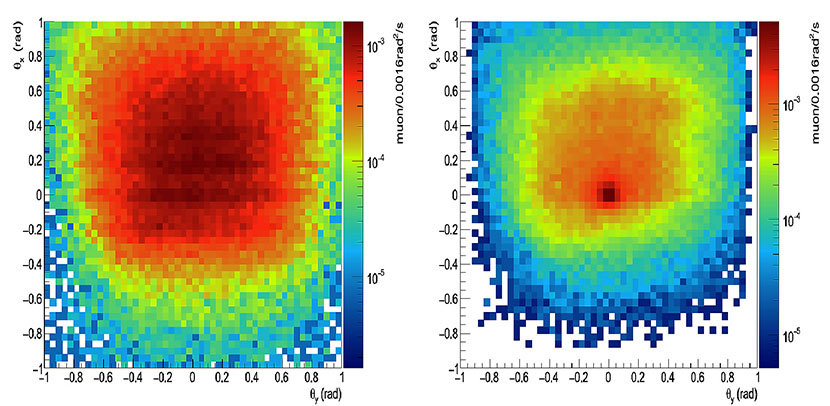
Figure 8. Data for the tunnel at the Laboratory’s TA-41 tunnel. (Left): Angular muon flux for the prototype Borehole Muon Detector. (Right): The Monte Carlo GEANT4 simulation. The tunnel entrance is toward the top.
Strict requirements of size, ability to withstand an underground environment, data transmission rate limitations, background effects, and performance requirements guide the development of a miniaturized muon-tracking detector deployed in a borehole. The primary technical challenges for the design include: 1) a miniaturized detectors capable of fitting in standard 7-inch diameter boreholes and 2) resisting the harsh underground conditions (e.g., pressure, heat, water, corrosive chemicals) for long periods of time.
To test the viability of this technique, researchers developed and tested a muon detector designed to function in boreholes. The inventors used the Monte Carlo code GEANT4 to simulate the anticipated detector response and tested the prototype Borehole Muon Detector in the Shallow Underground Laboratory at the Pacific Northwest National Laboratory and in the underground tunnel at Los Alamos’s Technical Area 41. The LANL tunnel is a decommissioned drift in the Bandelier Tuff units in Los Alamos Canyon, with a floor approximately 90 m below the mesa top above, and extending approximately 90 m into the side of the mesa. Los Alamos investigators used their expertise in muon imaging and particle detectors to run the Borehole Muon Detector against LANL’s well-characterized larger detector known as the Mini-Muon Tracker, which Subatomic Physics (P-25) researchers operate. The LANL researchers also analyzed data from the larger Mini-Muon Tracker to benchmark the borehole detector.
The Borehole Muon Detector system provided data acquisition sensitivity comparable to that of the Mini-Muon Tracker. This comparison has proved the technical and economic feasibility of a Borehole Muon Detector system, which is considerably smaller, lighter, and more portable than the Mini-Muon Tracker. Numerical modeling suggests the Borehole Muon Detector would be able to detect small changes in density, which are a proxy for fluid migration, as deep as 1,500 meters, which can be localized by the use of several detectors allowing researchers to build a tomographic image. The researchers have already developed a version that will be small enough for testing in a typical 7-inch-diameter borehole environment. The new design concept could fit into a pressure vessel with an outside diameter of 6 inches.
Reference: “A Novel Muon Detector for Borehole Density Tomography,” Nuclear Instruments and Methods in Physics Research Section A: Accelerators, Spectrometers, Detectors and Associated Equipment 851, 108 (2017). doi: 10.1016/j.nima.2017.01.023. Authors: Alain Bonneville, Richard T. Kouzes, and Jared Yamaoka (Pacific Northwest National Laboratory); Charlotte Rowe (Geophysics, EES-17); Elena Guardincerri, J. Matthew Durham, Christopher L. Morris, Daniel C. Poulson, and Jeffrey D. Bacon (Subatomic Physics, P-25); Deborah J. Morley (former LANL, now retired); Kenie Plaud-Ramos (former LANL student); James Bynes, Julien Cercillieux, Chris Ketter, Khanh Le, Isar Mostafanezhad, and Gary Varner (University of Hawaii at Manoa, Honolulu); and Joshua Flygare and Azaree T. Lintereur (University of Utah, Salt Lake City). Pacific Northwest National Laboratory led the cosmic ray muon project. Los Alamos project Principal Investigator (PI) Charlotte Rowe (Geophysics, EES-17) and co-PI Elena Guardincerri (P-25) managed LANL’s participation in the research.
The DOE’s Subsurface Science, Technology and Engineering Research, and Development (SubTER) Crosscut program funded the work. The research supports the Laboratory’s Energy Security mission area and its Science of Signatures science pillar via development of the capability to make measurements associated with environmental storage of CO2 and hydrocarbon production. Technical contact: Elena Guardincerri
Theoretical
HIV persists in macrophages during antiretroviral therapy
Human immunodeficiency virus (HIV) is one of the largest pandemics the world has ever seen. There are over 35 million people infected. Every year more than 1 million people die of AIDS, the end stage of HIV infection, despite the existence of relatively safe and efficient antiretroviral treatment. One problem is that this treatment can control the infection, but cannot eradicate it. Once treatment is stopped the virus almost invariably rebounds and the disease returns. There has been much research into the possibility of developing vaccines against this virus (where LANL is an important player) and the possibility of developing other treatment options that will lead to an effective cure and eradication of the virus from the infected individual.
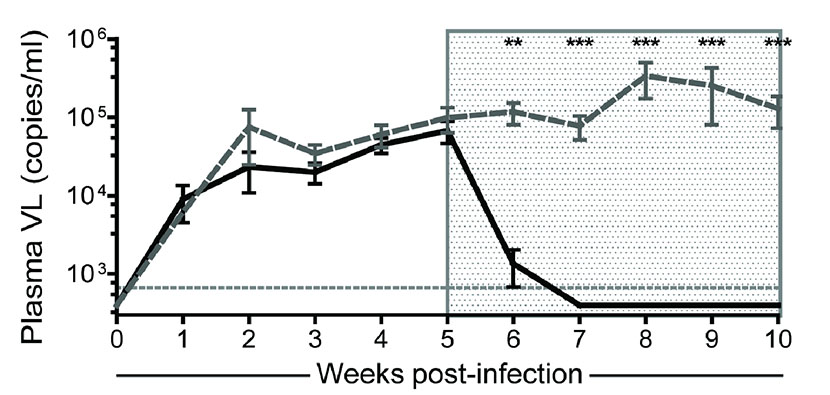
Figure 9. Antiretroviral therapy suppresses viral replication in humanized mice that only have macrophages and no T cells. Longitudinal analysis of the plasma viral load in HIV-infected mice. The solid black line represents the average (and s.e.m.) of 8 treated mice, compared to 6 untreated mice in the grey dashed line. The horizontal dashed line represents the limit of quantification of the assay used.
The University of North Carolina experimentalists have developed multiple types of genetically engineered mice to use in models of HIV infection. Some mice only have T cells, others only have macrophages, and still others have both types of cells. In all cases, these are human cells transplanted into the mice, so that they are susceptible to HIV infection – because mice original cells are not infectable by HIV. The investigators studied the dynamics of HIV infection and antiretroviral treatment in these models. The team analyzed the rates of viral decay and persistence during treatment. Researchers Ruy Ribeiro and Youfang Cao (Theoretical Biology and Biophysics, T-6) applied their expertise in modeling the viral dynamics of diverse infections.
The team made two surprising discoveries. 1) When macrophage-only infected mice were treated, their viral loads declined very rapidly. This result indicated that the turnover of these infected cells is fast and indeed much faster (at least a factor of 10) than previously thought from analyses of indirect human data. 2) Interruption of therapy in macrophage-only infected mice led to a late viral rebound and resulted in disseminated infection in 33% of the mice. This was surprising because it was not known that virus could hide in macrophages. Moreover, this process occurred even in the absence of T cells, which are the major target of HIV infection. The finding that HIV virus was never recovered in 67% of the mice after treatment ceased may indicate eradication of infection in those cases.
This is the first direct evidence of HIV persistence in tissue macrophages in vivo. These results have clinical implications, because they indicate that macrophages may be a reservoir where the virus hides and that macrophages might contribute to rebound of virus and infection after treatment in people. Therefore, possible therapeutic intervention to eradiate HIV may have to target two very different types of cells (T cells and macrophages). Obviously, mice are not humans. These proof-of-principle results should be considered in the context of a model of human infection. Ongoing studies are investigating whether macrophages can also be a hideout for HIV in human infection.
Reference: “HIV Persistence in Tissue Macrophages of Humanized Myeloid-Only Mice during Antiretroviral Therapy,” Nature Medicine 2, 638 (2017); doi: 10.1038/nm.4319. Authors: Jenn B. Honecutt, William O. Thayer, Caroline E. Baker, Rachel A. Cleary, J. Victor Garcia, and Michael G. Hudgens (University of North Carolina – Chapel Hill); Ruy M. Ribeiro and Youfan Cao (Theoretical Biology and Biophysics, T-6); Steven M. Lada (Veterans Affairs, San Diego Healthcare System); Douglas D. Richman (Veterans Affairs and University of California – San Diego).
The National Institutes of Health funded the Los Alamos work, which supports the Laboratory’s Global Security mission area and the Science of Signatures science pillar through modeling of and simulations of disease evolution and its treatment. Technical contact: Ruy Ribeiro





